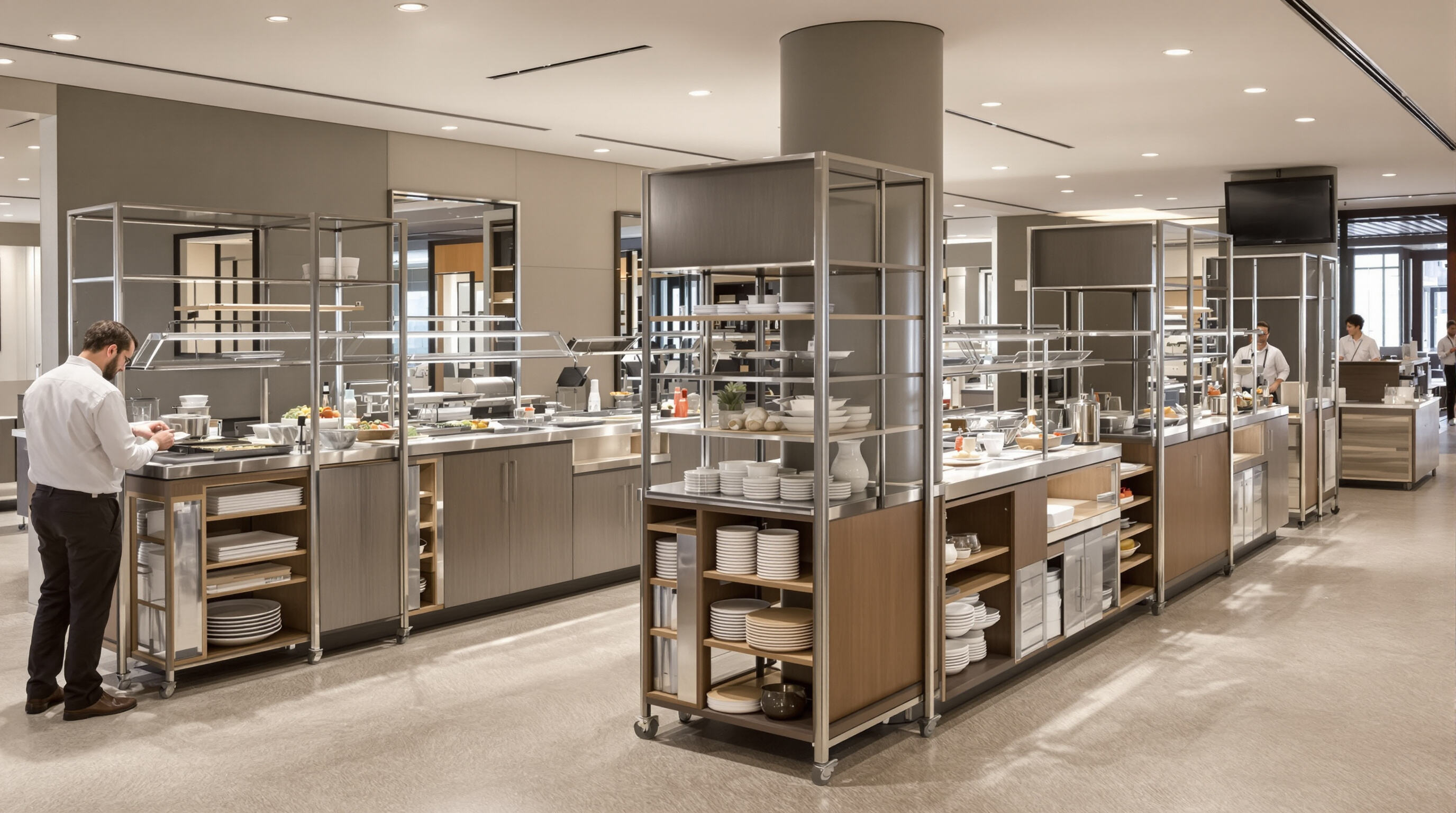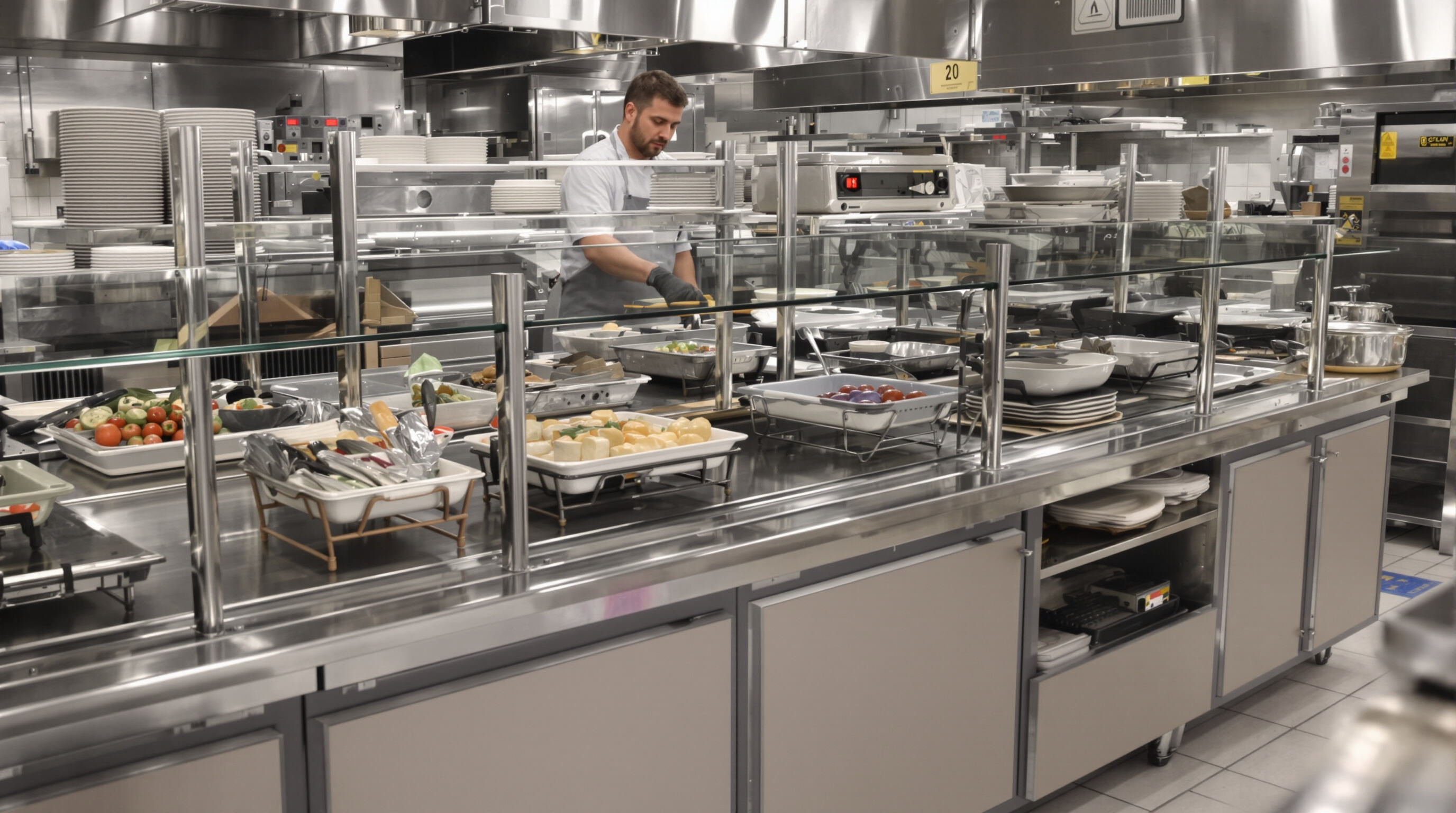Berita
Apakah Kelebihan Susun Atur Bufet Modular?
Fleksibiliti dalam Susun Atur dan Kebolehsuaian Perkhidmatan
Bagaimana Reka Bentuk Kenduri Modular Membolehkan Perubahan Susun Atur Secara Dinamik
Kenduri modular membolehkan premis mengubah kawasan perkhidmatan dalam masa minit menggunakan komponen yang boleh ditukar ganti. Berbeza dengan pemasangan tetap, sistem ini menyokong stesen berbentuk L untuk rehat persidangan, konfigurasi berbentuk U untuk majlis malam, atau aliran linear untuk sarapan dengan keluaran tinggi. Penyambung piawaian dan elemen yang boleh dikembangkan memastikan keutuhan struktur sambil membolehkan pelbagai susun atur.
Menyesuaikan Diri dengan Saiz Acara yang Berbeza Menggunakan Fleksibiliti dan Kebolehsuaian Sistem Modular
Sama ada mesyuarat kecil untuk kira-kira lima puluh orang atau majlis perkahwinan besar dengan hampir seribu tetamu, peralatan modular ini berfungsi dengan baik apabila disusun secara bertindih atau berjuntai bersama dengan cara yang bijak. Ramai hotel mendapati mereka mampu mengurangkan keperluan peralatan untuk acara kecil sebanyak 35-40% dengan menggunakan pangkalan padat yang berkembang ke atas melalui peningkat dulang kecil atau meregang ke sisi berkat sistem palang rentas. Keseluruhan susun atur ini memastikan tiada ruang yang terbiar kosong sambil mengekalkan kelancaran pergerakan antara bilik berlainan saiz. Perancang acara menyukai kefleksibelan yang ditawarkan sistem ini, terutamanya semasa musim puncak apabila setiap inci ruang sangat bernilai.
Kajian Kes: Menyusun Semula Susun Atur untuk Perkhidmatan Sarapan Pagi dan Makan Malam di Hotel
Salah satu jenama hotel besar berjaya mengurangkan masa persediaan bufet mereka sebanyak dua pertiga apabila beralih kepada sistem dapur modular ini. Untuk sarapan, para tetamu kini dihidangkan dengan stesen grab-and-go di mana bubur oat panas disediakan dalam modul pemanas khas sementara bar parfait sejuk berada sedia dalam tiang penyejuk. Apabila tiba waktu makan malam, susun atur tersebut berubah sepenuhnya kepada suasana yang lebih interaktif untuk jurumasak, lengkap dengan dapur induksi yang mudah dipasang serta dulang kecil yang tersorok untuk menadah rempah-rumpun yang jatuh. Yang lebih menarik lagi? Dengan susun atur yang fleksibel ini, kadar pusingan meja restoran meningkat sehingga 120% pada waktu sibuk seperti waktu makan tengah hari atau hujung minggu.
Kecekapan Operasi dan Pengoptimuman Tenaga Kerja
Menyekapkan Alur Perkhidmatan dengan Sistem Dapur dan Penyimpanan Modular
Komponen boleh laras dalam sistem buffet modular mengoptimumkan alur kerja di dapur dengan menyelaraskan kepada keperluan perkhidmatan tertentu. Zon suhu yang telah dikonfigurasi sebelumnya dan stesen yang boleh ditukar membantu menghapuskan kesesakan semasa waktu puncak, membolehkan jurumasak mengekalkan kualiti makanan sambil meminimumkan pertindihan antara kawasan penyediaan dan kawasan hidangan.
Mengurangkan Masa Pekerja dengan Kemudahan Pemasangan dan Nyahpasang
Mekanisme sambungan pantas mengurangkan masa persiapan sebanyak 35—50% berbanding susun atur tradisional. Komponen dipasang tanpa alat, membolehkan pasukan mengubahsuai stesen daripada sarapan ke makan malam dalam masa kurang daripada 20 minit. Resort melaporkan masa persiapan 30% lebih pantas (Laporan Operasi Hospitaliti 2024), menumpukan semula usaha staf ke peranan yang berinteraksi dengan tetamu.
Reka bentuk ergonomik mengurangkan risiko kecederaan staf semasa pemasangan dan nyahpasang
Rangka aluminium ringan dan penyambung gelangsar-dan-kunci mengurangkan pengangkatan berulang, yang merupakan punca biasa kecederaan pada susun atur konvensional. Pemegang berbentuk sudut mengikuti kedudukan genggaman semula jadi, mengurangkan tekanan pergelangan tangan semasa pengaturan semula yang kerap. Satu kajian keselamatan tenaga kerja pada 2023 mendapati 42% kecederaan sistem muskuloskeletal yang lebih rendah di tempat yang menggunakan reka bentuk modular ergonomik berbanding stesen tetap.
Pemaksimuman Ruang dan Inovasi Penyimpanan

Mengoptimumkan Jejak dalam Kawasan Makan Berkunjung Tinggi
Susun atur modular mengurangkan pembaziran ruang sebanyak 35% berbanding pemasangan tetap, membolehkan pelarasan secara masa nyata dalam persekitaran terhad. Stesen yang boleh diatur semula menghapuskan "zak zombi" kekal, dan permukaan boleh lipat membolehkan pengurangan jejak semasa waktu bukan puncak—tanpa mengganggu operasi.
Strategi: Menggabungkan Kepelbagaian Perabot Modular dengan Reka Bentuk Menjimatkan Ruang
Penyedia hospitaliti terkemuka mencapai susun atur katering yang 27% lebih padat menggunakan tiga taktik bersepadu:
- Paparan berbilang tahap : Tangga tingkat memampatkan stesen tanpa mengorbankan pelbagai pilihan menu
- Troli yang boleh ditukar : Unit mudah alih bertukar daripada penyimpanan kepada penghidangan dalam beberapa saat
- Sistem meja bersarang : Permukaan meja yang boleh diperluaskan sesuai untuk menampung tetamu daripada 50 hingga 500 orang
Pendekatan ini membolehkan tempat makan menempatkan 15% lebih banyak pelanggan sambil mengekalkan laluan 42" yang mematuhi piawaian ADA—kelebihan di ruang bandar yang berkos tinggi.
Pengalaman Tetamu yang Dipertingkatkan Melalui Penyesuaian Estetik
Penyesuaian dalam reka bentuk modular meningkatkan daya tarikan visual
Kaedah hidangan berkonsep modular mengubah stesen berfungsi menjadi pengalaman berjenama melalui elemen yang boleh dikonfigurasikan. Menurut Kajian Pengalaman Pelanggan PwC 2023, 65% tetamu sedia membayar lebih untuk persekitaran yang dipersonalkan. Hotel mencapai ini dengan:
- Panel permukaan meja yang boleh ditukar-ganti mengikut tema acara
- Penghadang selesema boleh laras ketinggian dengan pencahayaan bersepadu
- Kaki kelengkapan boleh tanggal untuk tanda berkala
Kajian persepsi tetamu: 78% mengaitkan susun atur buffet modular dengan pengalaman premium
Acara dengan stesen buffet boleh suai mengumpul tiga kali lebih banyak keterlibatan Instagram berbanding susun atur statik. Dalam Laporan Reka Bentuk Makanan & Minuman 2024, tetamu menggambarkan sistem modular sebagai "berprestij" (42%) dan "inovatif" (36%), berbeza ketara dengan label "am" yang digunakan pada barisan tradisional.
Keberkesanan Kos dan Pulangan Pelaburan Jangka Panjang Sistem Buffet Modular

Penjimatan Jangka Panjang daripada Ketahanan dan Penggunaan Semula Susun Atur Buffet Modular
Penggunaan bahan bermutu tinggi seperti keluli bersalut serbuk dan plastik gred komersial benar-benar membantu sistem-sistem ini bertahan lebih lama. Ini bermaksud penggantian dapat dikurangkan sebanyak 60 hingga 70 peratus. Selain itu, unit bermodul juga menawarkan fleksibiliti yang luar biasa kerana ia mudah disusun semula. Sebuah unit asas tunggal mungkin digunakan sebagai tempat sarapan pagi hari ini tetapi esok boleh diubah menjadi kaunter pencuci mulut tanpa banyak kesulitan. Menurut laporan industri terkini daripada F&B Equipment Trends pada 2023, pengendali restoran memerlukan sekitar 22% kurang bahagian pengganti dalam tempoh lima tahun apabila menggunakan sistem tahan lama ini.
Analisis Perbandingan: Sistem Tradisional Berbanding Modular dari Segi Kos Penggantian
Pemahaman Data: Purata Tempoh Pulang Modal 2 Tahun untuk Pelaburan dalam Peralatan Buffet Moden
Lebih daripada separuh pengendali (58%) memulangkan pelaburan permulaan dalam tempoh 24 bulan dengan mengurangkan tiga kos utama:
- Tenaga kerja : Menjimatkan 30—45 minit setiap hari dalam pemasangan dan pembongkaran
- Membuang : 18% kurang kerosakan melalui kawalan suhu yang tepat
- Penyimpanan : 40% kurang ruang diperlukan untuk komponen yang dipadankan
Strategi: Pelaksanaan Berperingkat untuk Menguruskan Kos Permulaan
Premis boleh memulakan perjalanan pelaburan mereka dengan memberi tumpuan kepada komponen utama terlebih dahulu, seperti rak paparan berbilang tahap yang menarik perhatian, sebelum mengembangkan lagi pada masa akan datang. Menurut kajian daripada Hospitality Tech Journal pada tahun 2023, satu syarikat kapal layar sebenarnya mendapati peningkatan sebanyak 19 peratus dalam pulangan pelaburan apabila mereka memperkenalkan sistem modular ini dalam tiga peringkat berasingan berbanding membelanjakan semua sekali gus. Kelebihan di sini adalah pendekatan langkah demi langkah ini mengekalkan aliran kewangan ke tempat yang diperlukan, sambil tetap memberikan peningkatan yang ketara serta-merta di kawasan sibuk seperti kaunter perkhidmatan minuman.
 SELEPAS JUALAN:
SELEPAS JUALAN:
 EN
EN
 AR
AR
 HR
HR
 NL
NL
 FI
FI
 FR
FR
 DE
DE
 EL
EL
 HI
HI
 IT
IT
 PT
PT
 RO
RO
 RU
RU
 ES
ES
 TL
TL
 ID
ID
 SL
SL
 VI
VI
 ET
ET
 MT
MT
 TH
TH
 FA
FA
 AF
AF
 MS
MS
 IS
IS
 MK
MK
 HY
HY
 AZ
AZ
 KA
KA
 UR
UR
 BN
BN
 BS
BS
 KM
KM
 LO
LO
 LA
LA
 MN
MN
 NE
NE
 MY
MY
 UZ
UZ
 KU
KU









